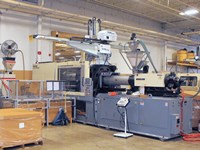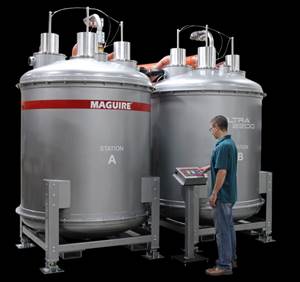Molder’s Message to Foreign Competitors: ‘Bring It On!’
An inspired combination of automation, ISO certification, use of certified resins, and strict adherence to a rigorous set of time-honed manufacturing standards are among the chief factors giving the Rodon Group, a 54-year-old custom molding operation in Hatfield, Pa., the confidence to boast that it can beat the pants off of Chinese part pricing, and Mexican pricing, too.And it’s not an idle boast.
An inspired combination of automation, ISO certification, use of certified resins, and strict adherence to a rigorous set of time-honed manufacturing standards are among the chief factors giving the Rodon Group, a 54-year-old custom molding operation in Hatfield, Pa., the confidence to boast that it can beat the pants off of Chinese part pricing, and Mexican pricing, too.
And it’s not an idle boast. The company captured a project for molding impact PS fruit skewers away from a custom molder in mainland China. Rodon runs the products faster, better, and cheaper here in mainland America, using six manufacturing cells with 64-cavity molds built in-house, in presses equipped with servo-powered robots.
As another example, Rodon molds toys—the famous K’NEX line of construction toys—at a lower cost than was quoted in China.
Its aggressively competitive business practices reportedly have enabled Rodon (rodongroup.com) to achieve a remarkable 99.92% Product Quality Acceptance Rate from its customers last year. These practices include turnkey project management, providing customers with a lifetime tooling guarantee, a zero-defect manufacturing model, and ISO and OSHA certification.
Eliminating supply-chain risks through JIT delivery, adherence to challenging lead times, and providing same-day order changes are among the company’s other standard practices.
The Rodon Group also provides open payment terms and tool financing programs for qualified customers, as well as complete adherence to non-disclosure agreements. And the absence of language and time-zone barriers also helps customers reduce risks incurred from shopping for parts offshore. Pricing in U.S. dollars also eliminates currency conversion costs and risks for domestic customers.
Lowell Allen, Rodon’s senior v.p. of manufacturing, says business is quite good for the company these days—so good that it has recently hired people for its production, QC, and tooling departments.
Rodon has invested substantially over the past decade in upgrading both its primary and secondary manufacturing machine capacity, another factor contributing to its success as a world-class competitor.
STANDARIZATION IS S.O.P.
According to Allen, standardization on particular equipment suppliers is standard operating procedure at Rodon Group. The biggest benefits are the ease of parts supply and better service. The company has 110 presses from 40 to 400 tons, all of them from Nissei (nisseiamerica.com). It also standardizes on robots from Star Automation (starautomation.com) and hot-air dryers from Matsui (matsuiamerica.com). Each manufacturing cell also is equipped with a silent-running, low-speed granulator, either from Matsui or a screenless model from SRS Corp. (srscorp.com).
Among Rodon’s more recent acquisitions are three of Nissei’s latest FNX Series hybrid presses. “They’re very energy efficient, and they’re quiet,” Allen says. “They’re equipped with what I believe to be a truly revolutionary servo-driven hydraulic pump.” The Hybrid System used on Nissei’s FNX presses uses an electric servomotor to drive the hydraulic pump. The servo and pump provide power only when it’s required and stop when power’s not required. As a result, the energy consumption is reportedly up to 55% lower than with Nissei’s straight hydraulic machines. Hydraulic oil temperature also remains lower, thereby reducing cooling-water requirements and reducing cooling tower expenses and maintenance costs.
Allen adds that the FNX machines are a great fit in a custom molding operation like Rodon’s, since they can handle a variety of molding jobs requiring hydraulic power—ones requiring considerable ejection force, high nozzle-touch force, and large shot capacity, for instance—with virtually the same energy efficiency as an all-electric.
AUTOMATION EVERYWHERE
Arranged on the floor by tonnage, all of the company’s presses are equipped with either a parts picker or a servo robot. “We’re running jobs that definitely wouldn’t be here without this automation,” says Allen, adding that the Group’s toolmakers engineer and manufacture all of its end-of-arm tooling. “We’ve got a couple of our toolmakers who are dedicated to end-of-arm tooling programs.”
Allen points out one cell, which produces a sensitive food-grade product with zero human contact. The parts are demolded by the robot and dropped into a box untouched by human hands.
Thanks to its dedication to automation, Rodon’s molding operation runs with only seven operators on the shop floor at any given time. Part boxes are automatically filled, indexed, and labeled. To provide 100% traceability, scanners read the boxes’ barcode labels and communicate wirelessly with the company’s MRP system.
“This data management system allows more accurate and timely purchasing decisions to be made. We’re not running out of product, while at the same time we are eliminating any ‘fire drills’ with our vendors,” Allen says.
IN-HOUSE MOLDMAKING
All of Rodon Group’s tooling is designed and built in-house, and all in 420 stainless steel. It has nearly 1000 active molds. The company employs 17 full-time toolmakers, who not only design and build molds, but also provide virtually all dimensional repairs. They also design and build all of the company’s indexing conveyor belts.
“Our expertise and specialized equipment allow us to work in very tight tolerances, leading to completed tools that achieve extremely consistent cavity-to-cavity dimensions,” says Allen.
Its moldmakers concentrate on close-tolerance, high-cavitation molds. Though they have built molds with up to 192 cavities, Allen says 96 to 128 cavities are more the norm.
Occupying a total of about 15,000 ft2, the Group’s toolroom is segmented into three areas—grinding and turning, CNC machining, and EDM. The centerpiece of its CNC machining room is a Mitsui Seiki VT3A vertical machining center (mitsuiseiki.com). It’s built for spindle speeds of up to 20,000 rpm, it cuts to within tenths of a millimeter, and it runs unattended. All six Mitsubishi sinker EDM machines are capable of automatic tool changes as well as unattended production.
“We run our tooling operations as overhead,” Allen says. “With that, we can get pretty aggressive on our project pricing—in fact, we’re happy to break even on a mold.”
MORE EFFICIENT LIGHTING
The lights come on automatically when you enter the company’s analytics lab on the way to the molding areas. The company switched from metal halide lights to bright T5 fluorescent lighting activated by motion sensors. Allen says they’re as economical as they are efficient. “We save about $5000 per month using them, and not only on our electrical costs. We aren’t changing the lights too often anymore. And, it’s now cooler in here in the summer. You can actually put your hands on these lights when they’re on.” Rodon performs all color and dimensional checks in this lab. “We’ll be installing a new Stream Plus 404 dynamic streaming vision measuring system from Mitutoyo QV (mitutoyo.com) in about a month,” he says.
Related Content
Novatec Announces Deal with Moisture-Analysis Specialist
Novatec will be aboni’s exclusive distributor in North and Latin America for offline moisture analyzer.
Read MoreHigh-Output Dryer Requires Less Energy
Maguire’s ULTRA 2200 is designed to meet high throughput requirements with a max capacity of 2200 lb/hr.
Read MoreBozzelli’s Guide To Specifying a Dryer
Here's a list of 17 things to do when looking for new drying equipment.
Read MoreWhy (and What) You Need to Dry
Other than polyolefins, almost every other polymer exhibits some level of polarity and therefore can absorb a certain amount of moisture from the atmosphere. Here’s a look at some of these materials, and what needs to be done to dry them.
Read MoreRead Next
Processor Turns to AI to Help Keep Machines Humming
At captive processor McConkey, a new generation of artificial intelligence models, highlighted by ChatGPT, is helping it wade through the shortage of skilled labor and keep its production lines churning out good parts.
Read MoreUnderstanding Melting in Single-Screw Extruders
You can better visualize the melting process by “flipping” the observation point so that the barrel appears to be turning clockwise around a stationary screw.
Read MorePeople 4.0 – How to Get Buy-In from Your Staff for Industry 4.0 Systems
Implementing a production monitoring system as the foundation of a ‘smart factory’ is about integrating people with new technology as much as it is about integrating machines and computers. Here are tips from a company that has gone through the process.
Read More














